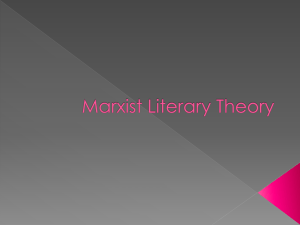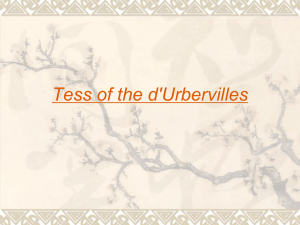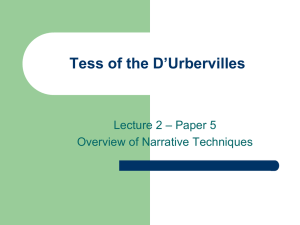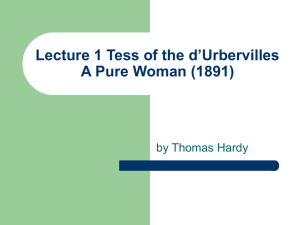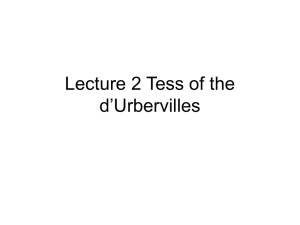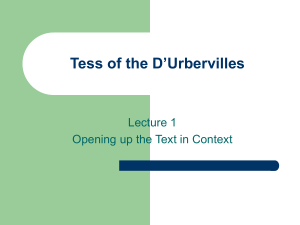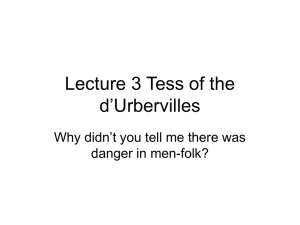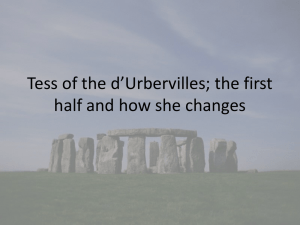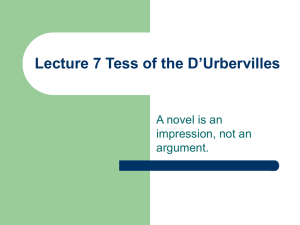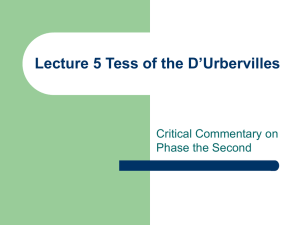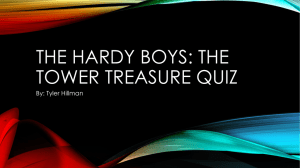Western Literature
advertisement
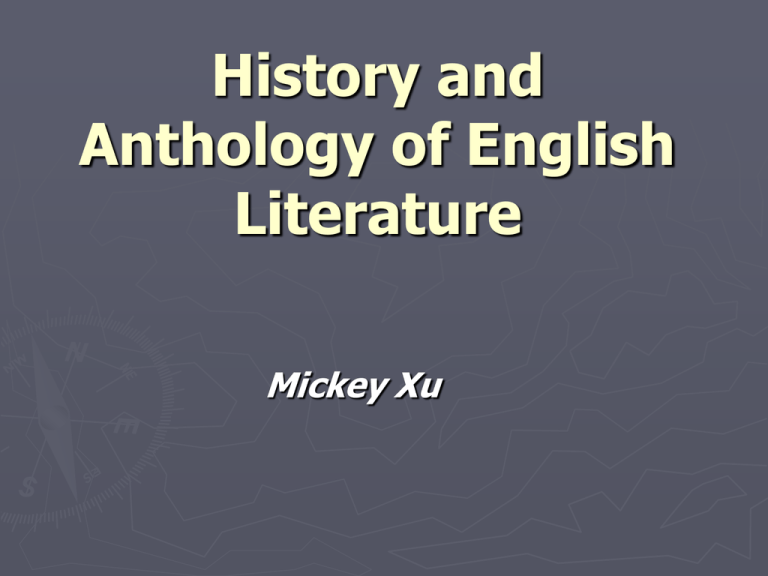
History and Anthology of English Literature Mickey Xu Literature in the 20th Century Background Poetry Aestheticism and Decadence Drama Fiction --The Realistic Novel --The Modernist Novel Literature in the 20th Century ► 1. Poetry Compared with the Victorian period, the 20th century has witnessed a great achievement in English poetry. 2. Aestheticism and Decadence 3. Fiction 4. Drama Thomas Hardy (1840-1928) Thomas Hardy (1840-1928) ► ► ► English poet and novelist, famous for his depictions of the imaginary county "Wessex" . Hardy's work reflected his stoical pessimism and sense of tragedy in human life. At the age of 22 Hardy moved to London and started to write poems, which idealized the rural life. In 1867 Hardy left London for the family home in Dorset, and resumed work briefly with Hicks in Dorchester. Emma Hardy died in 1912 and in 1914 Hardy married his secretary, Florence Emily Dugdale. Hardy died in Dorchester, Dorset, on January 11, 1928. His ashes were cremated in Dorchester and buried with impressive ceremonies in the Poet's Corner in Westminster Abbey. Dorchester, County Town of Dorset Thomas Hardy was born in Dorset, a rural region of southwestern England that was to become the focus of his fiction. Wessex novels About Wessex 1. name of a place 2. natural scenery of Wessex 3. writing style of local- color 4. figures in Wessex 5. imaginative Wessex Wessex Poems ► ► ► ► ► ► ► ► ► ► ► Wessex Poems, 1898 Poems of the Past and Present, 1901 The Dynasts, Part First, 1904 The Dynasts, Part Second, 1906 The Dynasts, Part Third, 1908 Time's Laughingstocks, 1909 Satires of Circumstance, 1914 Moments of Vision, 1917 Late Lyrics and Earlier, 1922 Human Shows, 1925 Winter Words, 1928 Short Stories Squire Petricks Lady The Withered Arm Poetry Ah, Are You Digging On My Grave? The Man He Killed Hardy’s novels ► ► The Poor Man and the Lady, never published Desperate Remedies, 1871 ► Under the Greenwood Tree, 1872 ► A Pair of Blue Eyes, 1873 ► The Hand of Ethelberta, 1876 ► The Trumpet Major, 1880 ► A Laodicean, 1881 ► Two on a Tower, 1882 ► The Woodlanders, 1887 ► The Well-Beloved, 1897 Kinds of His Novels a. Romances and fantasies b. novels of ingenuity c. novels of characters and environment ► pessimistic philosophy According to his pessimistic philosophy, mankind is subjected to the rule of some hostile mysterious fate, which brings misfortune into human life. ► strong elements of naturalism ► symbolism Naturalism: A post-Darwinian movement of the late 19th century that tried to apply the “laws” of scientific determinism to fiction. The naturalist went beyond the realist’s insistence on the objective presentation of the details of everyday life to insist that the materials of literature should be arranged to reflect a deterministic universe in which a person is a biological creature controlled by environment and heredity. Major writers include Hardy and Gissing in England; Crane, Dreiser in America. Tess of the d'Urbervilles Rising Action ► Tess’s family’s discovery that they are ancient English aristocracy, giving them all fantasies of a higher station in life; Tess’s accidental killing of the family horse, which drives her to seek help from the d’Urbervilles, where she is seduced and dishonored. Tess of the d'Urbervilles Climax ► Tess’s new husband discovers her earlier seduction by Alec and decides to leave her, going off to Brazil and not answering her letters, and bringing Tess to despair. Tess of the d'Urbervilles Falling Action ► Tess’s last-ditch decision to marry Alec, who claims to love her; Angel’s return from Brazil to discover Tess marriage to her former seducer, and his meeting with Tess; Tess’s murder of Alec and short-lived escape with Angel before being apprehended and executed. Summary: Chapter XIV ► The following August, Tess decides the time has come to stop pitying herself, and she helps her village with the harvest. Her baby boy, conceived with Alec, falls ill, and Tess becomes worried that he will die without a proper christening. She decides to christen him herself and names him Sorrow. When he dies the following morning, Tess asks the parson if her christening was sufficient to earn her baby a Christian burial. Moved, the parson replies that though he cannot bury the child himself, Tess may do so. That night Tess lays Sorrow to rest in a corner of the churchyard, and makes a little cross for his grave. Summary: Chapter XXXV ► Angel is distraught by Tess’s confession. He begs her to deny it, but she cannot. He flees the house, and Tess follows after him. For hours, they walk the grounds of the mansion. Tess tells her husband that she will do anything he asks and even offers to drown herself. Angel orders her to go back to the house. When he returns, Tess is asleep. After an uncomfortable moment looking at the d’Urberville ladies’ portraits, Angel goes to sleep in a different room. Themes ► Themes of Tess ► The injustice of existence ► Changing Ideas of Social Class in Victorian England Men Dominating Women John Galsworthy(1867-1933) one of the most prominent English realistic writers of 20th century, also a playwright and a stylist. 1. life ---born in a well-to-do bourgeois family ---studied law at Oxford, but took to literary work after graduation. 2. works ---The Island Pharisees: his first important social novel ---Forsyte Saga: the first trilogy 3. point of view The novels and plays of Galsworthy give a complete picture of English bourgeois society. 4. style ---strength and elasticity ---powerful sweep ---brilliant illustrations ---deep psychological analysis Oscar Wilde ► ► ► Oscar Wilde is the representative among the writers of aestheticism and decadence. He was son of an Irish surgeon educated at Oxford where he imbibed the influence of Ruskin and posed as a leader of the younger aesthetes. In 1895 he was sentenced to two years' imprisonment on a charge of sexual immorality and he went to France after his release. His best-known comedies: Lady Windermere's Fan A Woman of No Importance An Ideal Husband The Importance of Being Earnest Stream of Consciousness A narrative technique for rendering the inward experience of a character. This technique is designed to give the impression of an everchanging series of thoughts, emotions, images, and memories in the spontaneous and seemingly illogical order that they occur in life. The textbook example of stream of consciousness is the last section of James Joyce's Ulysses. David Herbert Lawrence (18851930) life Story --born in Eastwood, Nottinghamshire --father, a coal-miner; mother, a middle-class woman and a school teacher, and had a deep influence upon his life. --worked for a time as a teacher after receiving education at local schools and at Nottingham University College. --In 1912, met Frieda, a German noblewoman and the wife of a professor at Nottingham University, fell works Sons and Lovers The Rainbow Women in Love Lady Chatterlay’s Lover His influence D. H. Lawrence was regarded as revolutionary as Joyce in novel writing; but unlike Joyce, Lawrence was not concerned with technical innovations, his interest lay in the tracing of the psychological development of his major characters and the criticism of the dehumanizing effect of the capitalist industrialization on human nature. George Bernard Shaw (1856-1950) Life Story ---born in Dublin, Ireland; father, a petty offical ---at the age of 14, after graduating from middle school, Shaw was put into a job as clerk in a land agent’s office. ---at 20 he went to London where he remained jobless for 9 years, living in his mother’s house and devoting much tome to self-education. ---Shaw was a friend of progressive mankind; He supported the forces of revolution and democracy in their struggle against imperialism and reaction. ---In 1931, Shaw visited China and was warmly received by the revolutionary people represented by Lu Xun and others. works Widower’s Houses Mrs. Warren’s Profession Heartbreak House Major Barbara Pygmalion The Apple Cart Saint Joan style ---Shaw is a critical realist writer. His plays bitterly criticize and attack English bourgeois society. ---His plays deal with contemporary social problems. He portrays his situations frankly and honestly, intending to shock his audiences with a new view of society. ---He is a humorist and manages to produce amusing and laughable situations. Virginia Woolf ---born on January 25, 1882, one of four children, daughter of biographer and critic Leslie Stephen (later Sir Leslie) and Julia Jackson Duckworth. educated at home by her father; voracious reader of books in father’s library. ► married Leonard Woolf, a critic and writer on economics and politics. Virginia Woolf, her husband, her siblings, and their friends became known as the Bloomsbury Group. ► In 1917 the Woolfs founded Hogarth Press ► Her mother’s death in 1895 trigger the first mental breakdown. When father died in 1904, suffered a second breakdown and attempted suicide by jumping out of window. ► On Match 28, 1941, she left notes for her husband Leonard Woolf and sister Vanessa before drowning in the River Ouse. Major Works early novels—The Voyage Out (1915), Night and Day (1919), and Jacob's Room (1922) ► To the Lighthouse (1927) ► Mrs. Dalloway (1925) ► Orlando (1928) ► The Waves (1931) ► A Room of One’s Own (1929) ► Three Guineas (1938). ► The Common Reader (1925) and The Common Reader: Second Series (1932). ► The Diary of Virginia Woolf. ► Woolf's Stylistic Features ► Stream of consciousness (interior monologue, soliloquy) ► Time schemes ► Symbolism and imagery: thin thread of human connection, mesh, net for human relationship (p82) ► Loose syntax ► Multiple narrative voices ► Coherent device ► Irony Mrs Dalloway Summaries and Commentaries ► Mrs. Dalloway is not a novel that chronicles the years of the life of Clarissa Dalloway. In fact, Mrs. Dalloway is not a conventionally narrated novel at all. It is a collage, a mosaic portrait Themes ►communication and connection people long for but fail to achieve especially between people who are apparently close People don’t say what they feel. Style: ►portrayal of subjective world flow of consciousness, floating from the mind of one character to the next ►two time schemes: physical and actual time vs. subjective and mind time James Joyce (1882-1941) one of the most original novelists of the 20th century, whose work shows a unique synthesis of realism, the “stream of consciousness” and symbolism. life ---an Irishman born into a Catholic family in Dublin. ---educated at Jesuit schools; a good student and intended for a priest, but lost faith ---entered Dublin College, read books forbidden by the Catholic Church, refused to take part in the nationalist movement ---lift Ireland and lived in France, Italy and Switzerland as “a voluntary exile” ---suffered from an eye disease, stayed abroad all his life and lived all his life on the verge of poverty ---had a proud, stubborn character major works a. A Portrait of the Artist as a Young Man b. Dubliners c. Ulysses d. Finnegans Wake Two Periods ► His first two books deal with the life of Ireland that he rejected when he went to live in exile. ► His last two books represent his second period. In them, Joyce tried to understand and explain the development of an artist and the workings of the human mind. Dubliners may be arranged into four categories as follows: 1. 2. 3. 4. Stories of childhood stories of adolescence stories of mature life stories of public life. His Point of View ► He believed that there are 3 stages of literature: ► 1. lyrical form (personal, emotional) ► 2. narrative (no longer purely personal) ► 3. dramatic (the highest, perfect stage) ► significance of his works a. He changed the old style of fictions and created a strange mode of art to show the chaos and crisis of consciousness of that period. b. From him, stream of consciousness came to the highest point as a genre of modern literature. c. In Finnegans Wake, this pursue of newness overrode the normalness and showed a tendency of vanity.
